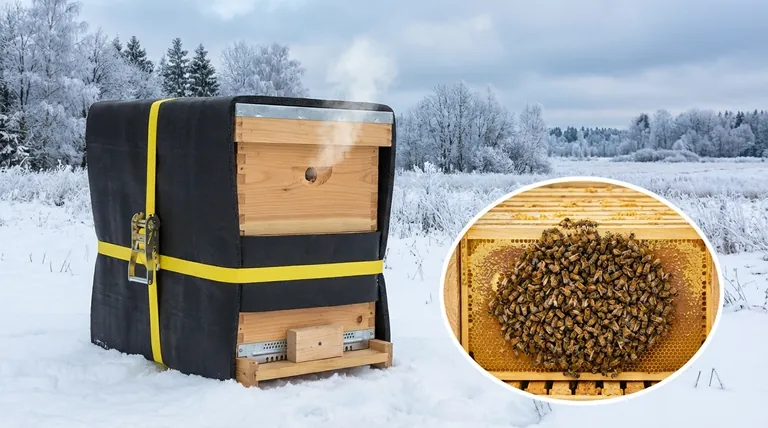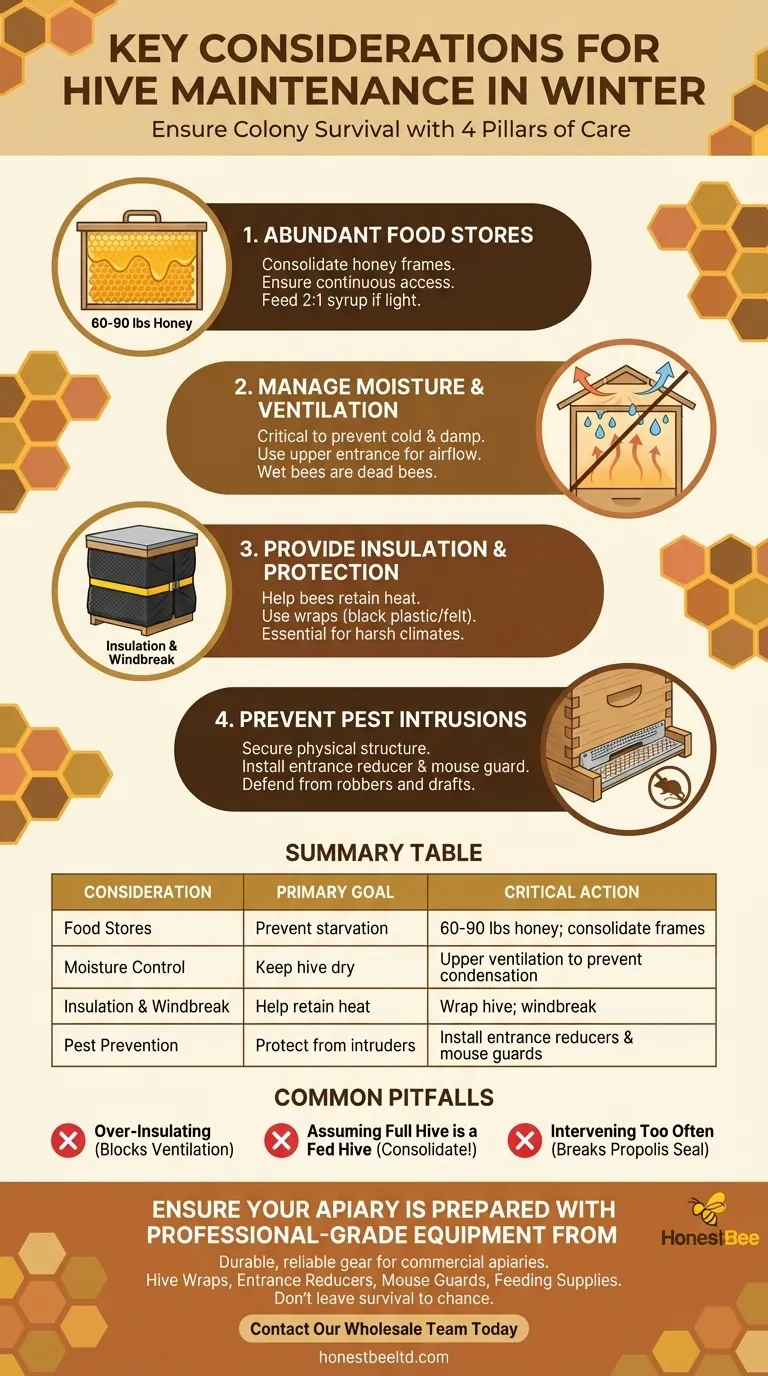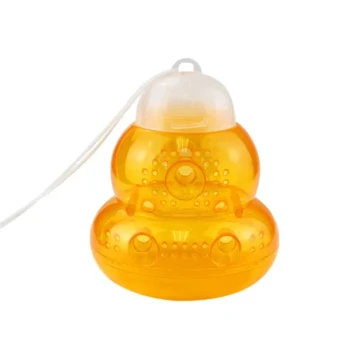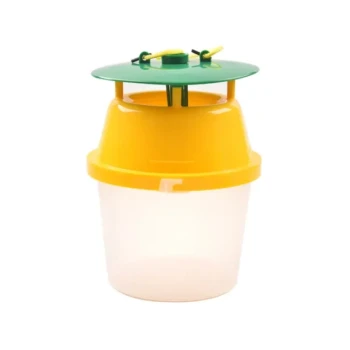To ensure hive survival in winter, your primary considerations are guaranteeing sufficient food stores, managing internal moisture through proper ventilation, providing insulation and protection from wind, and preventing pest intrusions. These four pillars work together to help the bee cluster regulate its temperature and survive until spring.
The core challenge of winter beekeeping is not just fighting the cold, but managing the deadly combination of moisture and cold. A dry, well-fed colony can survive low temperatures, but a damp colony cannot.

The Foundation: A Strong and Well-Fed Colony
Your winter preparations begin long before the first frost. The health and population of the colony entering winter are the single most significant factors in its survival.
Ensure Abundant Food Stores
A typical colony needs 60-90 pounds of honey to survive the winter. Bees use this honey as fuel to generate heat by vibrating their wing muscles, forming a thermoregulated "winter cluster."
Starvation is a leading cause of winter colony death. After your fall honey harvest, you must assess their stores and feed them a 2:1 sugar-to-water syrup if they are light.
Consolidate Honey Frames
During deep cold, the bee cluster may be unable to move to find food in other parts of the hive. You must arrange the frames in the fall so all the honey is consolidated together, ensuring the cluster has continuous access to its food source as it moves slowly through the hive.
Start with a Healthy Population
A strong, populous colony with a healthy queen is crucial. Throughout the summer and fall, you must manage for pests and diseases, with a special focus on Varroa mites. A high mite load in the fall leads to a weak, virus-ridden colony that is unlikely to survive winter.
The Balancing Act: Insulation vs. Ventilation
Once food and health are addressed, you must protect the hive from the external environment. This involves a careful balance between holding in heat and letting out moisture.
The Purpose of Insulation
The goal of insulation is not to "heat" the hive, but to help the bees retain the heat they generate. It reduces the energy they must expend to keep the cluster warm.
Wrapping hives in a material like black plastic or roofing felt is a common practice. This wrap serves two functions: it provides an insulating layer and acts as a windbreak, which is critical for preventing heat loss.
Why Ventilation is Non-Negotiable
As bees consume honey, they release a significant amount of water vapor. In a cold hive, this warm, moist air will rise and condense on the cold inner surfaces, creating water droplets.
This condensation will drip down onto the cluster, chilling the bees. Wet bees are dead bees. Proper ventilation allows this moist air to escape before it condenses. Many hive wraps incorporate an upper entrance hole specifically for this purpose.
Fortifying the Hive Against External Threats
A winter hive is a warm, food-rich target for various pests. You must secure the hive's physical structure.
Install an Entrance Reducer
Reducing the size of the main hive entrance with an entrance reducer is essential. It helps the bees defend their colony from robbing insects and prevents cold drafts from entering the hive.
Use a Mouse Guard
Mice seek warm, sheltered spaces in winter and will readily move into a beehive. They will destroy comb, eat honey and bees, and create a mess that can doom the colony. Installing a mouse guard—a strip of metal with holes large enough for bees but too small for mice—is a simple and vital step.
Understanding the Common Pitfalls
Success in wintering a colony often comes from avoiding a few critical mistakes.
Pitfall: Over-Insulating and Blocking Ventilation
The most common error is sealing a hive too tightly. In an attempt to keep the colony warm, beekeepers inadvertently trap moisture, creating a damp, cold environment that is far more lethal than the outside air temperature alone. Always prioritize a dry hive.
Pitfall: Assuming a Full Hive is a Fed Hive
As mentioned, bees may not be able to cross empty frames to get to honey on the other side of the hive box. Do not assume they are safe just because there is honey somewhere in the hive. Consolidating food stores near the cluster is crucial.
Pitfall: Intervening Too Often
Winter inspections should be minimal to non-existent. Opening the hive breaks the propolis seal the bees have created and releases their carefully regulated heat, causing immense stress. Most winter work is "hands-off" monitoring, such as checking for activity on warm days or hefting the hive to estimate its weight.
Making the Right Choice for Your Climate
Your specific actions will depend heavily on your local climate.
- If your primary focus is a mild winter climate: Prioritize adequate food stores and robust Varroa mite management. While insulation is less critical, moisture control via an upper entrance is still vital.
- If your primary focus is a harsh winter climate: Insulation, wind protection, and consolidating honey stores are just as critical as food levels and moisture control. A multi-faceted approach is non-negotiable.
- For all beekeepers, regardless of location: The strength and health of the colony entering winter is the ultimate determinant of success. You cannot save a weak, disease-ridden colony with wraps and feeders alone.
By preparing for these core challenges, you give your colony the best possible chance to not only survive the winter but to emerge strong and ready for the spring.
Summary Table:
| Key Winter Hive Consideration | Primary Goal | Critical Action |
|---|---|---|
| Food Stores | Prevent starvation | Ensure 60-90 lbs of honey; consolidate frames |
| Moisture Control | Keep the hive dry | Provide upper ventilation to prevent condensation |
| Insulation & Windbreak | Help bees retain heat | Wrap hive with black plastic or roofing felt |
| Pest Prevention | Protect from intruders | Install entrance reducers and mouse guards |
Ensure your apiary is prepared for winter with professional-grade equipment from HONESTBEE.
As a trusted supplier for commercial apiaries and beekeeping equipment distributors, we understand that a successful winter depends on durable, reliable gear. Our wholesale-focused operations provide the essential supplies you need to protect your investment:
- High-Quality Hive Wraps & Insulation to help your colonies retain heat.
- Durable Entrance Reducers and Mouse Guards to keep pests out.
- Feeding Supplies to support strong food stores.
Don't leave your colony's survival to chance. Let HONESTBEE be your partner in beekeeping success. Contact our wholesale team today to discuss your winter equipment needs.
Visual Guide

Related Products
- Professional Galvanized Hive Strap with Secure Locking Buckle for Beekeeping
- Professional Grade Foldable Beehive Handles
- Premium Comfort Grip Spring-Loaded Hive Handles
- Professional Drop-Style Hive Handles for Beekeeping
- Black Plastic Beetle Barn Hive Beetle Trap for Beehives
People Also Ask
- What maintenance is required for hive straps? A Guide to Cam Buckle vs. Ratchet Strap Care
- What are the types of Emlocks available? Choose the Right Strap for Hive Security
- Why are hive straps important for beekeepers? Secure Your Hives Against Wind, Predators & Transport
- How can beekeepers secure the top cover of a hive? Protect Your Colony from Wind and Weather
- What are the two styles of hive straps? Choose the Right Strap for Your Hive Security



















